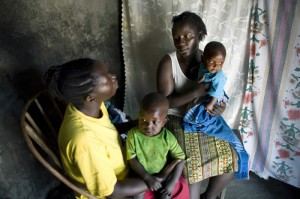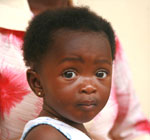 Stephanie Martin, IYCN’s behavior change communication specialist, shares the project’s experience integrating nutrition into community-based HIV prevention activities in Kenya’s Western Province.
Stephanie Martin, IYCN’s behavior change communication specialist, shares the project’s experience integrating nutrition into community-based HIV prevention activities in Kenya’s Western Province.
How is the IYCN Project integrating infant feeding into HIV programs?
Last year, IYCN collaborated with USAID’s AIDS, Population and Health Integrated Assistance (APHIA) II Western Project, led by PATH. We worked together to integrate infant feeding counseling and support into their existing community-level activities in Kenya’s Western Province. As part of APHIA II Western, the Society for Women and AIDS in Kenya’s (SWAK) community level workers were already conducting home visits, facilitating discussion groups, and organizing community mobilization activities related to HIV prevention, care, and support. Although these workers were sharing information and providing support to families affected by HIV, they had not received specific training on infant feeding and HIV. We thought this was an exciting way to ensure that HIV-positive mothers could receive the support and information they needed to make safer infant feeding decisions.
We started by developing a two-day training guide and participant’s manual on infant and young child feeding and supporting 15 training workshops for more than 400 community workers. We chose the training content based on extensive formative research conducted by PATH. The training covers supporting optimal infant feeding practices, safer infant feeding in the context of HIV, overcoming barriers to optimal practices, addressing common myths, referring women to services, and developing action plans to include infant feeding into existing HIV activities. We also printed take-home brochures on optimal infant feeding practices for community workers to share with members of their community.
What have you learned from this experience?
We discovered that community-level HIV projects provide an excellent opportunity to support HIV-positive mothers to practice safer infant feeding in order to prevent malnutrition and improve HIV-free survival for their children. Because APHIA II Western-supported community workers were already supporting HIV-positive mothers in communities, they were ideally positioned to share infant feeding messages and provide support for optimal feeding practices.

Community counselor Irene checks in on Phylis and her two children during a home visit in Western Province, Kenya.
This intervention worked because discussing safe infant feeding practices ties in well with the HIV prevention counseling that community workers are already offering to families. For example, some community workers facilitate discordant couple support groups in which participants discuss how to prevent HIV in their families. So it is a natural fit for the groups to also discuss prevention of mother-to-child transmission during breastfeeding.
In addition, we found that integration was highly cost effective and time efficient. We saved time and money by leveraging existing trainers and community workers who had already been trained in counseling, facilitation, community mobilization and HIV. These efficiencies allowed us to train far more people than if we had done it on our own.
How is integrated programming making a difference for mothers and children?
Fears around mother-to-child transmission of HIV can lead to dangerous feeding practices. Community workers who are already providing support and services to families related to HIV can now answer questions, provide support and refer to services related to infant and young child feeding and prevention of mother-to-child transmission. As a result, we were able to support more women and families to safely feed their children. In the six months following the training, community volunteers had reached more than 34,000 community members in Western Province with infant feeding support.
What recommendations would you give to colleagues seeking to integrate with HIV programs?
It is important to talk with potential partners about their needs and have them identify the best ways to work together to share resources, collaborate on activities, and tie messages together. It is also critical to use formative research to assess needs and develop targeted training content and messages for mothers and families.
Learn more:
Slideshow: Promoting better nutrition for children in Kenya’s communities
Kenya Infant Feeding Assessment: Eastern and Western Provinces
Kenya infant feeding brochures
Photos: Aurelio Ayala III, Philippe Blanc, Evelyn Hockstein
Date: Mar 9, 2011 | Category: Q&As
